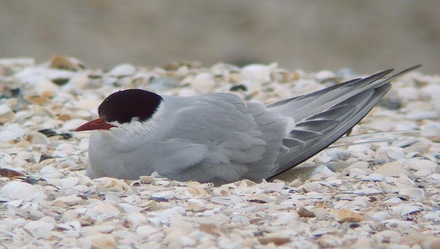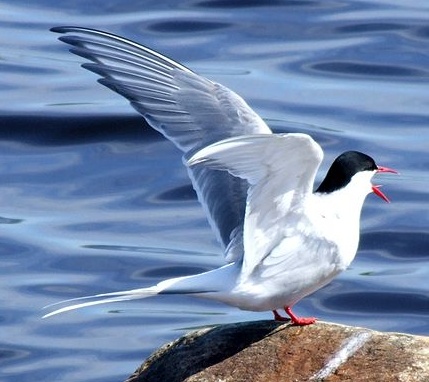
image credit - christoph meuller; creative commons license

The ARCTIC TERN is a small seabird that makes the longest migration of any bird - 22,000 miles or 35,000 km each year between the Arctic and the Antarctic. In May they arrive at their breeding grounds in the Arctic to nest and raise the young. In August the terns leave the Arctic to fly to the Antarctic.DESCRIPTION
- black cap from neck to beak
- slender, pointed, red bill
- bill is spearlike
- short red legs
- has webbed feet but does not swim well
- body : grey back, white-grey underparts, white cheeks
- wings : upperwings grey, whitish under wings, thin dark edge
- tail - long, white and grey , forked
- length 30 to 38 cm. (12 to 15 inches)
image - Alastair Rae , Flickr.com; license - Creative Commons
image - polandeze, Flickr.com; license - Creative Commons
HABITAT, RANGE (map)
- breeding areas - Arctic and sub-Arctic regions of Europe and Asia, northern Alaska, across northern Canada
- also northern British Columbia, northern Manitoba, Quebec, and Massachusetts (USA)
- nests in colonies on coasts, islands and inland on tundra near water
- winters on edge of pack ice in Antarctica
Arctic Tern looking for food
Dirk Ingo Franke ;Wikimedia; license - Creative CommonsFOOD
NESTING, EGGS, YOUNG BIRDS
- mostly small fish, shrimp, krill
- also catches flying insects
- flies over water then plunge-dives
- dips down to surface of water to catch prey close to surface
- may also steal food from other birds
- female lays two eggs (sometimes 3)
- cream-coloured eggs, brown-black-grey blotches and specks, hard to see
- nest is dent in the ground (in gravel or grass) ( photo )
- lined with smooth flat stones, sometimes plants or grass
- nest in colonies of over 50 birds
- both parents sit on nest and feed fish to the hatchlings
- hatchlings are gray or brown balls of fluffy down, with speckles ( photo)
- leave nest in a few days and hide nearby
- parents feed the chicks 3 to 4 weeks till they can fly
a hatchling covered with fluffy down
image from Wikipedia ; license - public domainPROTECTION from ENEMIES
ADAPTATIONS
- enemies are Arctic fox and humans
- birds like gulls and jaegars eat eggs and chicks
- sounds a piercing alarm call at intruders
- dive-bombs at enemies, aims at the head
- attacks with sharp, pointed beak
- nests in colonies for protection
There are several adaptations that help Arctic terns survive in their habitat. They are excellent fliers and are able to fly long distances every year between the Arctic and the Antarctic. Terns spend most of their lives in the air except when nesting.
The shape of the tern's body makes it such a good flier. The Arctic tern has a small body with long pointed wings and a long pointed tail. Hollow bones makes the bird's body light.
The sharply pointed bill helps it catch food. The tern can hover over schools of fish, shrimp or krill and then dive down.
Before the long journey to the Arctic terns moult. They lose their old feathers and grow new ones for the flight.
They nest in colonies for protection against predators. Terns cry out loudly, swoop down at an intruder and attack. They will dive at the intruder's head over and over again.

image from Wikipedia ; license - public domain
MORE INTERESTING FACTS
The tern rests on blocks of ice at the edge of the pack ice in the Antarctic.
The Arctic Tern can live more than 20 years (up to 34 years old).
Most Arctic Terns return to the same area where they hatched.
Terns migrate offshore (over sea not land). The journey takes 90 days.
The COMMON TERN has longer legs, more black on the wings, lighter grey underparts, a shorter tail, and an orange-red bill with a black tip. The ROSEATE TERN is much paler, with a dark bill, longer legs and long white tail streamers. The FORSTER'S TERN has whiter wings and belly, orange bill with black tip and longer, brighter orange legs.
| The Arctic ** INTRODUCTION ** PEOPLE ** ANIMALS ** PLANTS ** ARCTIC INDEX |
other image credits:
two chicks with adult - courtesy of Steve Johnson; Flickr.com; license -
Creative Commons
Map - courtesy of
Andreas Trepte;
Wikipedia; license - Creative Commons Attribution ShareAlike 2.5 License
information from :
Cornell Lab of Ornithology |
Avian Web